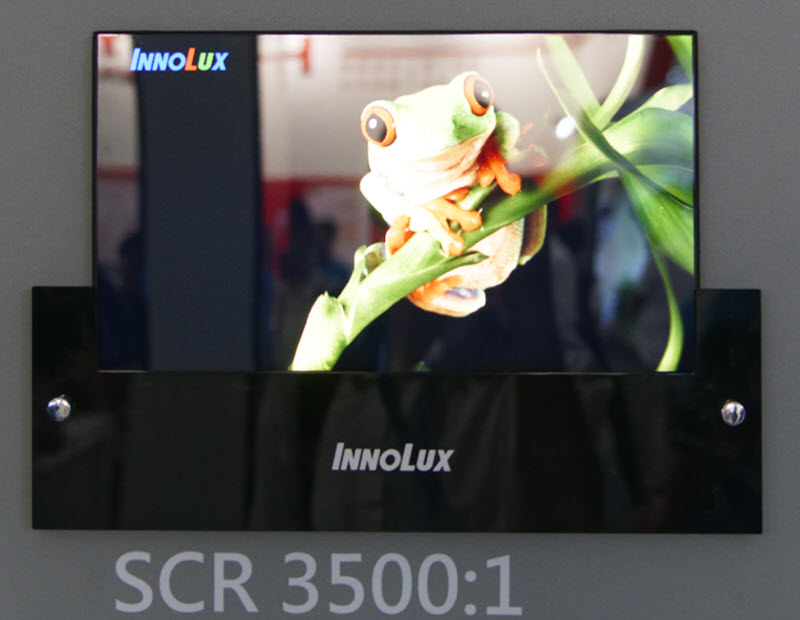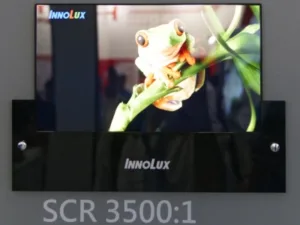Last week and yesterday, I posted pieces about some of the work at ITRI that was talked about at Touch Taiwan. But there was much, much more to see. It’s no surprise that miniLED and microLED were both big topics at the event. But I’ll start with a development in touch.

Since Apple released the iPhone, PCap touch technology has increasingly taken over the touch market. However, it has been hard to make in larger sizes and over the years since that launch, the maximum size using that technology has kept increasing. At the show, GIS, a Foxconn company and a specialist in touch technology had a demonstration of a 100″ PCap display, using unidentified metal mesh as the electrode material. It looked good and the metal mesh was not visible from the front of the screen (a problem with some of the larger solutions). The company couldn’t tell us when it would be in the market or what it would cost, but just to make it work is an impressive achievement. In production, the company does have the capacity to make 85″ displays and they were also on show.
 GIS showed the largest PCap display we have seen at 100″. Image:Meko
GIS showed the largest PCap display we have seen at 100″. Image:Meko
Also in the touch area for large displays, Nippon Electric Glass (NEG) was talking about using its very thin and flexible G-Leaf glass in a roll-to-roll process to allow the deposition of electrode layers directly on the glass. The use of thin glass would help the sensitivity of the touch system as well as reducing the parallax errors that are a nuisance when there is a thick cover glass.
We spoke to a number of companies about miniLED backlights which were being shown in all sizes of LCD, from displays for VR headsets, smartphone, automotive applications, notebooks, monitors and TVs. A wide range of different numbers of LEDs and zones were being shown with hundreds to thousands of zones. The results were impressive and there is clearly a solid supply chain building up very rapidly. The key promise of these technologies is to deliver the high contrast ratio of OLED, but without the issues of lifetime and burn-in -issues that make it particularly hard to qualify OLEDs in demanding applications such as automotive. TV users also want high contrast and miniLED is being developed for that application, although cost will be a challenge, initially. AUO is also developing HDR monitor panels for gamers using the technique. Nvidia showed an HDR monitor developed with AUO at CES in 2018 and both Asus and Acer announced monitors using the panel, but they have taken a long time to get to market as there have been significant integration challenges. AUO assured us that the panel hasn’t been the problem.
 NationStar showed this miniLED backlight for 27″ and 32″ panels. Image:Meko
NationStar showed this miniLED backlight for 27″ and 32″ panels. Image:Meko
Another topic that was less highlighted at the show, but is also a way to achieve very high contrast, is the dual layer panel technique. This is a topic we have been covering for three years or so (we’ve tagged many of the articles, so you can find more here ) We heard at SID that Hisense planned to use an Innolux panel in a double panel UltraHD TV in early 2020, but at Touch Taiwan, Innolux showed a very good looking 8K panel that uses an UltraHD modulation layer. However, AUO is not convinced about the technology and is concentrating on miniLED (and Innolux was hedging its bets by hav
There wasn’t a lot of other 8K technology at the show, but Chi Mei Visual Technology showed a wide angle viewing film that can be used with 8K TVs to improve the viewing angle without the need for so many VA domains. VA has very good performance when viewed ‘on axis’, but performance drops sharply off-axis, so panel makers use multiple domains of liquid crystal material in each pixel. These need individual control, with different ‘gamma’ characteristics, to get good viewing angles. That complicates things and reduces the aperture ratio compared to simpler architectures. At 8K, the loss of efficiency becomes a real problem, and we have seen sample images on Samsung 8K TVs that show that its attempts to maintain wide viewing at 8K are actually reducing the full resolution. (although this is a subtle effect – when we were shown the problem, the company that revealed it gave us a magnifying glass – so the effect is probably not apparent at normal viewing distance. But then, it can be argued that 8K isn’t, either!)

While I’m talking about contrast, there have been some interesting developments in contrast ratios for some IPS panels. Normally, while IPS LCDs have very good viewing angle performance, with well maintained colours and fairly consistent contrast – at least over a normal viewing cone – they typically only have from 1,000:1 to, perhaps, 1,500:1 contrast (without backlight modulation). AUO had a panel at 2,200:1 (although, as at SID, we weren’t able to find out what they are doing) while Innolux went further and showed an IPS panel with 3,500:1 contrast. Again the company wouldn’t confirm what they are doing, but I am pretty confident that the method is to use collimated light through the LCD and then to use a film to broaden the emission on the front of the panel. The clue was that Innolux confirmed to me that it is using a similar technology for its LCDs with ‘privacy mode’ and they do use control of the angle of the light that enters the display from the backlight.

I’m hoping to come back to more about microLED from the show in a subsequent DD article.

